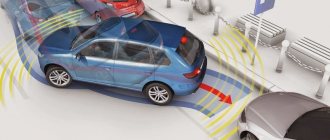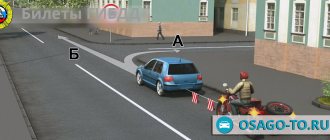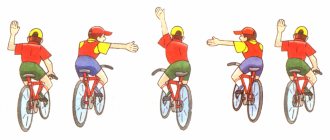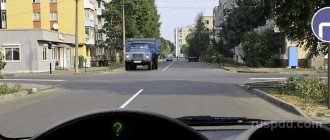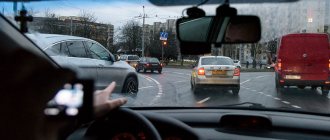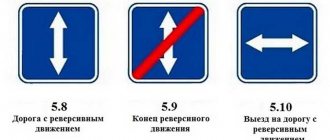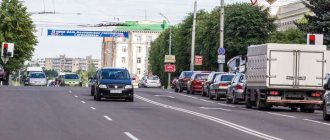Are you allowed to make a U-turn on a narrow roadway and enter a yard?
| 1. | No. |
| 2. | Yes. |
| 3. | Yes, if no interference is created for other road users. |
Reversing is prohibited at an intersection. However, the entrances to courtyards are not intersections. This means that using the entrance to the yard and driving into it in reverse for a U-turn is permitted if no interference is created for other traffic participants.
Signs prohibiting reversing
One of these restrictions is the “no entry” sign, since its location on a certain section of the road means that cars, in principle, cannot drive there. However, this restriction does not apply to route transport.
If the car owner drives in reverse contrary to this sign and enters a one-way highway, he may lose his license for a period of 4 to 6 months. Or he will need to pay a fine, the amount of which is not less than 5,000 rubles.
In federal cities such as Moscow and St. Petersburg, the fine for entering a route lane will be 3,000 rubles.
In other regions, the amount is halved and amounts to no more than 1,500 rubles. If an entry was made under a “brick”, then the driver will be fined at least 500 rubles for driving into the adjacent territory. The positive point is that the car owner cannot be deprived of his license as an administrative penalty.
Another limiter is the “no traffic” sign, which applies to both lanes. According to the Rules, this sign should not be installed at the entrance to the highway. But the penalty for this violation when reversing will be at least 500 rubles.
Is the driver allowed to reverse in the absence of other road users?
| 1. | Allowed, but only up to the pedestrian crossing. |
| 2. | Forbidden. |
Reversing on roads marked with a one-way road sign is not prohibited. But since there is a pedestrian crossing on the path of travel, where reversing is prohibited, the driver can reverse on this section of the road only up to the pedestrian crossing.
Fines for illegal reversing
If an accident occurs, the cause of which was the movement of one of the vehicles in reverse, then the driver whose car was in oncoming traffic in relation to the main flow will be found guilty. The amount of the fine depends on the circumstances under which the accident occurred.
- If the car was driving in reverse on a highway , the car owner is liable to a fine of at least 2,500 rubles. This measure is regulated by Article 12.11 of the Code of Administrative Offences.
- When reversing along a dividing strip or shoulder , the driver faces a fine of at least 500 rubles, in accordance with clause 9.9 of the traffic rules.
- Reversing at a pedestrian intersection - a fine of 100 rubles.
Video: reversing at an intersection and the size of the fine.
Who is to blame for an accident when driving in reverse?
In the event of an accident involving a person driving in reverse, who is at fault? The answer to this question may not be entirely unambiguous. In general, if traffic participants did not violate traffic rules, then most likely the driver of the car who was moving in reverse will be to blame for the accident. If the driver decides to move in reverse, then he must make sure that his maneuver is safe, but if these requirements are not met, then the driver is at fault.
At the same time, a situation cannot be ruled out when the culprit of an accident may be the person of the car that drove into the vehicle moving in reverse. Then the culprit will be the person driving the car and driving into a vehicle moving backwards.
Thus, who is to blame for an accident when one of the drivers was moving in reverse depends on the specific situation. However, a priori the person whose vehicle was moving backwards is considered guilty.
A situation may arise when the drivers of both vehicles are to blame for an accident.
USEFUL : often when rules are violated, an accident occurs. If you need to dispute the blame for a traffic accident, then read more at the link, and also watch the video
Where is it prohibited to drive in reverse?
How to properly park in reverse between cars
If, when driving in the opposite direction, you hear a beep, then stop the car as soon as possible. It’s better to stay for a couple of minutes, get out of your car and look around, than to crash into someone else’s car and spend a lot of time filling out documents about the accident and resolving issues with the insurance company and car service center. 4. When driving between parking rows, carefully watch for cars on the left and right
Please note that you should also keep an eye on neighboring cars if you are parked
For example, if you give way to vehicles that have the right of way. Unfortunately, in practice you can meet drivers who do not understand the meaning of the sound signal and do not react to it in any way. Just keep in mind that if the car continues to move, it is best to move away from the deaf driver.
In this case, you should only drive forward. Engaging in reverse gear can make you the culprit of an accident. A collision can occur if the driver of a parking car is not confident in using the rear-view mirrors (for example, using only the right mirror instead of all three).
Most often, an accident occurs between a car parallel parking (orange) and a car "propped" from behind (green). However, more exotic situations are also possible.
Ticket 19 question 9
The driver accidentally passed the required entrance to the yard. Is it legal to use reverse in this situation and then turn right?
Reversing is permitted on one-way roads. Of course, it is necessary to make sure that no one is interfered with in this situation, but, nevertheless, the maneuver indicated in the figure is permitted.
Ticket 20
13-12-2017, 08:42
When is it okay to drive in reverse?
When you do not interfere with other traffic participants, there are no intersections nearby, there are no “No Turning” or “No Entry” signs. It is possible if you are at exits or entrances to courtyards and adjacent areas.
Yes, if you are on a one-way road. You can drive in reverse in parking lots very carefully, again, if you do not disturb anyone with these actions and do not provoke an accident. Your maneuvers should not force other road users to slow down or change their trajectory. Before you start moving back, you need to let all cars and all pedestrians pass.
Very often, careless drivers who were reversing and drove into cars behind them begin to lie that they actually drove into them. If there is no car recorder, then it will be extremely difficult to establish the true culprit without witnesses. Judicial practice is such that the one who was behind and did not keep his distance is most often found guilty. In such cases, you need to look for witnesses of the accident through social networks, look for street surveillance cameras and ask to seize the video from them; or there is a high probability of an innocent person being accused. A car camcorder would be an ideal witness.
When traffic regulations prohibit reversing
The general requirement for reversing is determined by clause 8.12 of the Traffic Regulations - the maneuver must be safe for other road users and not interfere with other vehicles and pedestrians. This is a very subjective requirement, as each driving situation is unique. When you start reversing, you can be completely confident in the safety of your actions. However, a sudden appearance of a pedestrian or a car at high speed can lead to a collision. Additional difficulties may arise when making turns, driving around corners, or other non-standard movements.
Interestingly, the traffic rules contain special prohibitions on reversing. This is usually due to the special status of the road infrastructure object or the increased danger of maneuvering backwards. Reverse driving is prohibited:
- on the territory of specially equipped pedestrian crossings (may be indicated by signs, zebra crossings, etc.);
- throughout the tunnels;
- while the vehicle is on high-rise road infrastructure (bridges, overpasses, overpasses, viaducts), as well as directly under them;
- on the territory of a railway crossing (it is important that this is not only the rails themselves, but also the entire gap between the warning signs);
- in the area of public transport stops (usually they are indicated by signs or special markings);
- on highways marked with special signs;
- on the territory of intersections (in this case the number of intersecting roads does not matter);
- in traffic areas where visibility in one direction does not exceed 100 m (a very subjective factor that is often used when defending in court);
- in places where turning around when driving forward is prohibited.
Find out more General power of attorney for a car with the right to sell
There are also general restrictions that apply simultaneously to forward and reverse driving. For example, you need to take into account prohibitions on moving along medians, along bicycle paths, and in a number of other places.
Legal advice . In my practice, there was a case when a driver was released from liability for deliberately reversing at a railway crossing. The fact of traffic violation was obvious and was caught on the video camera. In court, we indicated that the reversing was caused by the need to remove an obstacle for the Gazelle, which was trying to leave the rails. According to the Code of Administrative Offenses of the Russian Federation, the court has the right not to impose punishment if the culprit violated the rule in order to ensure the safety of other persons and prevented more serious consequences. But this is an exceptional case, since usually the punishment will follow in full.
To avoid penalties for driving in reverse, always follow the road signs and markings, take into account the moment of entry into special objects (tunnels, bridges, etc.). Try not to drive even one wheel onto medians, lawns, pedestrian crossings and paths. Cameras and video recorders are now filming almost every section of the road, so it will be difficult to challenge the punishment.
Is reversing allowed in a populated area?
There are no special prohibitions or restrictions on reversing. Therefore, in urban traffic conditions, you need to take into account the general traffic rules - do not start maneuvers at intersections, in the area of bus and tram stops, or in other similar places. The order of crossing pedestrian crossings deserves special attention. On them, even when driving forward, additional precautions must be taken. If you have to make a U-turn or other reversing maneuver, take the time to get out of the car and check for signs and zebra crossings.
At special road infrastructure facilities
As stated above, bridges, tunnels, overpasses, highways and other special objects on the road are included in the list of prohibited places for reversing. You will likely see warning signs when approaching these objects. If a breakdown occurs or you encounter an insurmountable obstacle, it is better to call support or wait for other help.
Is it possible to drive in reverse during training?
During the on-road training period, the student must follow the instructions of the program director. Therefore, you can start reversing with the permission of the mentor and in compliance with the general traffic rules. Please note that in order to consolidate theoretical training, the mentor may give instructions on a maneuver with a deliberate violation of traffic rules. If the student is officially driving under the supervision of a teacher, there will be no punishment for such a violation.
Find out more What is mini CASCO insurance
Reverse driving technique
In order to reverse a truck into a parking space or carefully bring it to a loading ramp, not only a certain dexterity is required, which comes with long practice. factors need to be taken into account :
- correct location of the tractor and truck relative to each other and surrounding objects;
- the angle and direction of rotation of the steering wheel at each moment of the maneuver;
- determination of the truck's turning axis;
- timely leveling of the cab and alignment of the tractor and trailer in one line.
It is more convenient to place the trailer at a slight angle to the cabin, turning it slightly to the left. With this arrangement, the car will make a left turn. This helps to improve control over the behavior of the semi-trailer or van.
Before starting to move back, the vehicle must be positioned so that the cab door faces a conditional obstacle, which, after completing the maneuver, will be located parallel to the right side of the van.
This “obstacle” could be a nearby car, the wall of a building, or even a marking line in a parking lot. Having started moving with the truck in this position, the driver will be able to immediately adjust the angle at which the trailer enters the turn.
Truck driver backs up
Correcting course does not require constant rotation of the steering wheel from side to side. It is necessary to turn the steering wheel slightly and give the truck the correct angle of movement, and immediately begin the reverse rotation to align the tractor with the trailer. Due to the high inertia of a heavy van, the steering wheel will return to its original position at the same time as the trailer is leveled.
When driving a truck, it should be noted that the conventional axis of rotation of a trailer or semi-trailer is usually not in its geometric center and not at the very end.
To control the correct turn, the driver must monitor the point in the area of the central axis and the location of the rear corner of the truck relative to this point.
We invite you to watch the truck driver’s detailed explanations about the technique of driving a truck in reverse:
Driver location
The location of the driver in the tractor cab when reversing the truck must provide the solution to two main problems:
- the ability to control the environment and direction of movement of the van;
- the ability to respond in a timely manner to changes in traffic patterns and the occurrence of unexpected circumstances.
To perform these tasks, you must not only see everything through the mirrors, but also look out the window. At the same time, it is necessary to have access to all vehicle control systems at any time.
Monitoring the situation from the window
Adjusting the mirrors
All modern trucks and tractor-trailers are equipped with large rear-view mirrors. They are located on both sides of the cabin.
It is not necessary to know how much a truck wheel weighs in order to drive a vehicle correctly.
To avoid blind spots, they must be adjusted so that the driver can see the last third of the side of the trailer . Sometimes it won't hurt to install additional mirrors.
Rear view mirrors
Aligning the tractor and trailer and turning the steering wheel
If you need to change the angle of rotation of the trailer in one direction or another, you need to start smoothly turning the steering wheel in the required direction, while simultaneously monitoring the change in the position of the trailer by shifting the “turning point”. Almost immediately after giving the truck the desired angle, you need to start smoothly turning the steering wheel back.
The rotation speed must be such as to prevent the rear of the trailer from moving in the opposite direction.
The return of the steering wheel to its original position must coincide with the moment the van is set on the correct course and the simultaneous arrival of the cab in line with the trailer.
You can see how to turn the steering wheel correctly here:
What is reversing according to traffic regulations?
The traffic rules do not define such a maneuver as reversing. In most cases, the driver begins to move backward to make a U-turn, exit a parking lot or garage, or try to avoid obstacles ahead. To ensure the safety of such maneuvers, modern cars are equipped with rear view cameras, car parking and control systems. The increased danger when reversing is associated with the following points:
- The driver's visibility is significantly reduced, as a result of which a stationary obstacle, another car or a pedestrian may not be noticed;
- reversing involves moving in the direction opposite to the main traffic flow, which creates difficulties in maneuvering and controlling;
- When reversing, special driving skills are required, especially for large vehicles.
The traffic rules do not contain road signs or markings prohibiting or permitting reversing of a vehicle. However, the Rules contain clauses 8.12 and 16.1, which contain special rules for such maneuvers. They apply on a par with regular traffic rules and regulations.
Ticket 34 question 9
The driver accidentally passed the required entrance to the yard. Is he allowed to use reverse in this situation and then turn right?
The rules prohibit reversing where route vehicles stop, even if this does not interfere with other traffic participants. This limitation is, of course, due to the fact that bus stops are characterized by
Ticket 35
13-12-2017, 08:34

